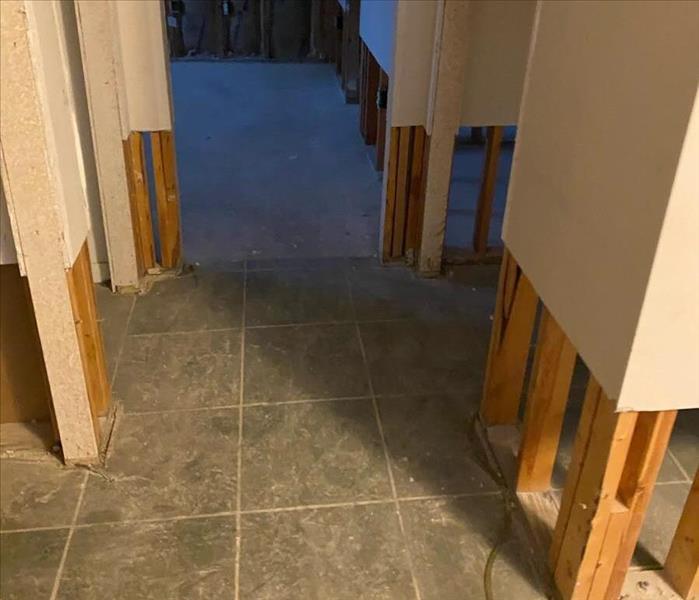How Does Moisture in Materials Get Resolved for Flooded Los Angeles Homes?
8/26/2020 (Permalink)
 SERVPRO Can Offer Storm Damaged Los Angeles Properties Water Extraction, Drying, Controlled Demolition, and Build Back--Just Call Us!
SERVPRO Can Offer Storm Damaged Los Angeles Properties Water Extraction, Drying, Controlled Demolition, and Build Back--Just Call Us!
After a flood, water removal techniques can be vital to protect more of the damaged areas of your residence.
Flooding can present some immediate concerns for Los Angeles homes. When natural flooding is happening, these concerns often gravitate towards contaminants and cleaning, though with clean water events, this emergency can have disastrous impacts on a property. The fast movement of standing water and water flow from structural breaches can be the worst for the most sensitive materials installed in your house. Elements like drywall and carpeting, for as common as these are, can be among the hardest hit by flood conditions.
Removing water and other flood mitigation for Los Angeles homes and businesses does not exclusively refer to pooling on the property's floors. While standing water must get addressed with the appropriate mitigation equipment, trapped moisture can be just as destructive and detrimental to the house. Careful considerations must get made about the affected materials and the best approaches to remove moisture and trapped water. From concrete masonry units in the foundation or surrounding the crawlspace to gypsum and carpeting, our strategies vary based on the severity of the exposure.
Do Emergency Services Help?
The general contractors and qualified flood restoration technicians of our SERVPRO team can ensure that the right measures are taken immediately to protect your property best. Often this process involves several direct actions getting taken as soon as our professionals first arrive. Reducing the continued flooding of the property and the migration of floodwater is a focal point of any successful flood restoration strategy. The elements of these plans often include:
- Board Up – Structural concerns are not uncommon with flooding, especially when these conditions follow severe weather in the area that could break windows, remove siding, and leave other vulnerabilities. This phase of repair ensures that these damage points do not allow for further flood damage.
- Tarping – Much like board-up services, tarping focuses on breaches to the roof, which can almost be expected when monsoon season damages the Greater Los Angeles area.
- Content Relocation – To many homeowners, personal belongings mean as much as the structure. Getting these items to a safe location during early flood mitigation can ensure that avoidable irreparable damage does not occur.
- Controlled Demolition – General contractors from our roster can inspect the property for weaknesses and structural concerns that must get replaced.
What Is the Difference Between Permeability and Porosity?
Regarding the drying and water removal efforts necessary to recover damaged contents and structural elements in a flood-damaged house, understanding specific terminology can help. Permeability and porosity both involve the movement of water through materials. Permeability is water's ability to move through a material, and certain elements vary in degrees of this permeance. Likewise, porosity gauges the composition of materials to determine the likelihood of absorption when exposed to water. There are three main degrees of porosity ratings for materials and contents:
- Porous – Materials like carpet and drywall allow the fast absorption of water when exposure occurs. These materials are also quickly irreparably damaged by oversaturation.
- Semi-Porous – Some materials can absorb water to the point of damage, but this does not happen immediately, such as exposed hardwood flooring.
- Non-Porous – Glass, tile, and similar materials are often impermeable for water. These materials cannot become damaged by absorbing water.
What Are the Obstacles of Hygroscopic Materials?
Hygroscopic materials refer to a select grouping of structural elements that are highly permeable and porous, making them fast targets for floodwater exposure. Because of how quickly these surfaces and items can become damaged, a swift reaction from responding technicians can prevent the need for tear-out and reconstruction or replacement. While the finite timeline can be a substantial obstacle, these materials can often dry quickly with the right approaches, such as centrifugal air movers, dehumidifiers, and other equipment.
- Insulation
- Carpet
- Upholstery
- Fabrics
When Does Reconstruction Happen?
Reconstruction is often an inevitable outcome when restoring flood damages and effects on a house. Whether it is repairing the damage to a roof after torrential rainfall and compromising winds, or it is removing interior drywall and framing to replace it when these elements become oversaturated. With contractors (General Contractor License #: 999460)
California State License Board (CSLB) #: 999460) on our roster, we have building trade professionals that can begin these repairs and reconstruction needs when mitigation and restoration complete.
As challenging as water removal can be, understanding elements like porosity and permeability can ensure that the right equipment and strategies get implemented to restore the property as much as possible. Give our SERVPRO of Silver Lake / Echo Park team a call today at (213) 628-2000.






 24/7 Emergency Service
24/7 Emergency Service